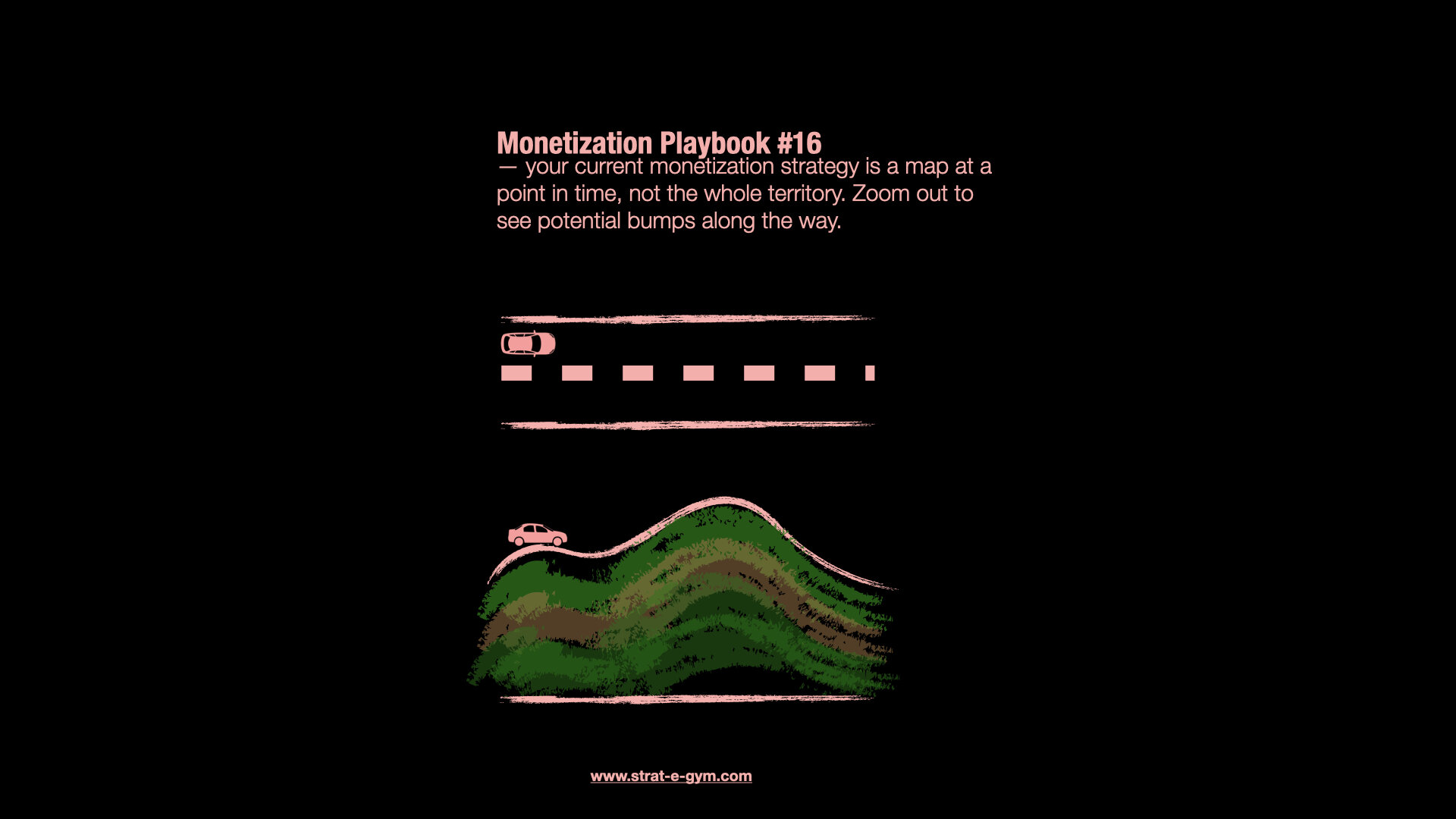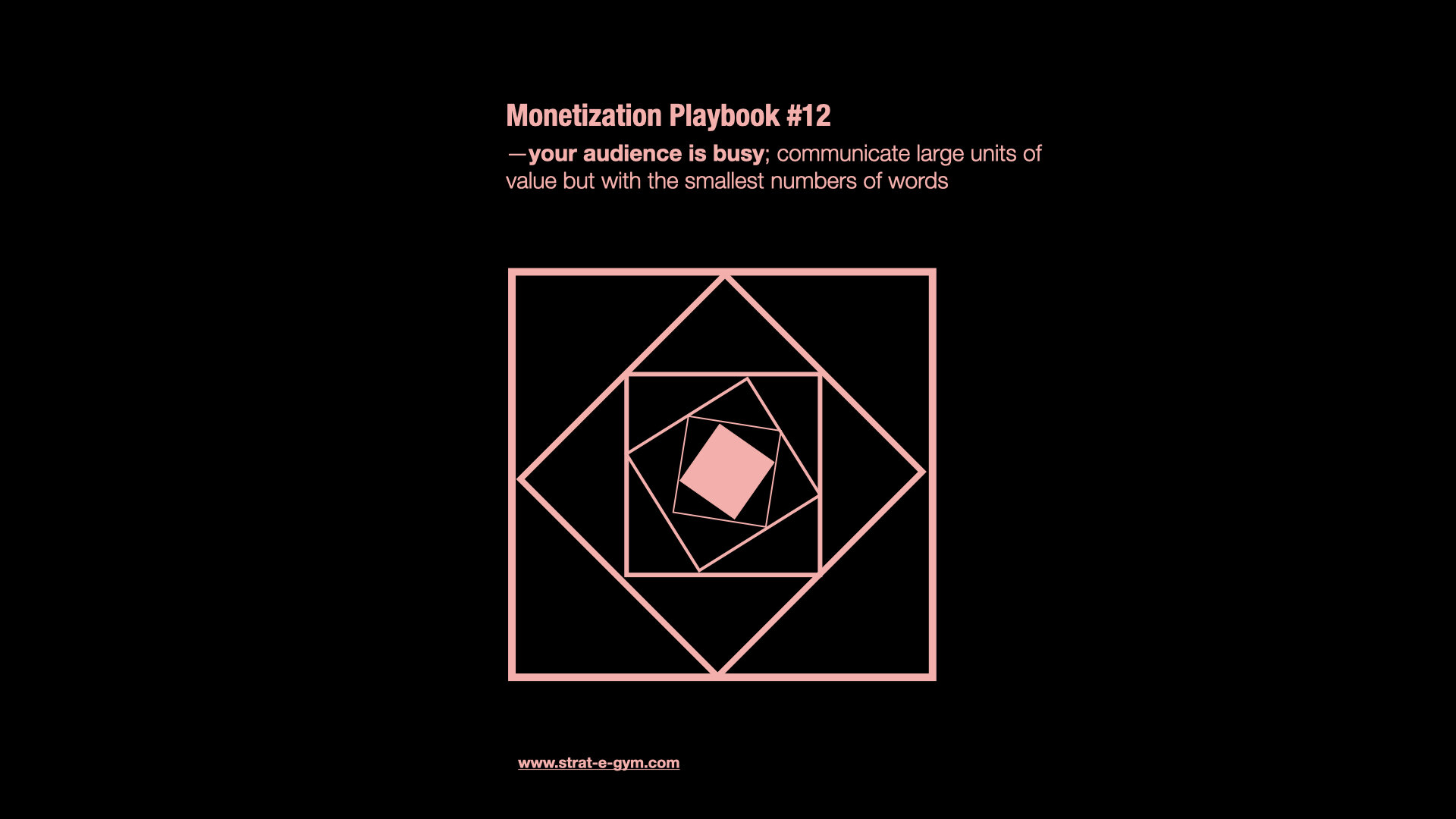Monetization Playbook #20: Intelligence has no gender.
— intelligence has no gender.
inspired by Mary Wollstonecraft (1759-1797)
Monetization Playbook #18: Eating Complexity—Television
— to increase monetization; eat your customer’s complexity. Eating complexity is the new Ramen! Every startup should live and breathe this soul-food.
Monetization Playbook #19: Eating Complexity—Directions
— to increase monetization; eat your customer’s complexity. Eating complexity is the new Ramen! Every startup should live and breathe this soul-food.
Monetization Playbook #17: To increase monetization; solve a different customer problem
— to increase monetization; solve a different customer problem
Monetization Playbook #14: Aim to create 10X-20X more customer value than you capture.
Aim to create 10X-20X more customer value than you capture
Monetization Playbook #15: If you can’t explain your monetization strategy simply—it’s not a strategy!
— if you can’t explain your monetization strategy simply—it’s not a strategy!
Monetization Playbook #16: The map and the territory.
— your current monetization strategy is a map at a point in time, not the whole territory. Zoom out to see potential bumps along the way.
Monetization Playbook #13: Don’t be average, avoid the mediocre middle when launching new products
Don’t be average, avoid the mediocre middle when launching new products
Monetization Playbook #12: Your audience is busy; communicate large units of value but with the smallest numbers of words
Your audience is busy; communicate large units of value but with the smallest numbers of words
Monetization Playbook #11: How to build relationship capital by increasing user purchase eXperience — just like Amazon
—how to achieve startup success beyond product market fit.
…inspired by ‘The Four Fits’ - Brian Balfour [Reforge]
Monetization Playbook #9: Always consider 3 ways to sell the same product
—freemium is like a Samurai sword: “unless you’re a master at using it, you can cut your arm off.”
Rob Walling
Monetization Playbook #8: Freemium is like a Samurai sword
—freemium is like a Samurai sword: “unless you’re a master at using it, you can cut your arm off.”
Rob Walling
Monetization Playbook #7: How to think of creating content by mining and farming.
Kick-start a content factory.
The internet is awash with content––much as California was perceived to be flush with gold in the 1840s. So how do you form a strategy to get in on the gold rush. Where do you start prospecting?
Luckily, we can draw inspiration from many a miner's commandments written in 1849 [source California historical society]
I. Thou shalt have no other claim than one.
Don't try to be an expert in everything.
II. Thou shalt not make unto thyself any false claim
Share what you know. Share what you believe. Share what you've researched. But don't blag it!
III. Though shalt not think more of all thy gold
Content isn't about you. No one cares about you. No one cares how well you're doing––unless, of course––you're inspiring and teaching others how you got there.
IV. Thou shalt not steal a pick, or a shovel, or a pan from thy fellow-miner
Austin Kleon tells us to steal like an artist. But "don't just steal the style, steal the thinking behind the style." But always give credit.
V. Thou shalt not grow discouraged, nor think of going home before thou hast made thy "pile
You have to stick at it. It'll flow. But not without pain!
Man cannot remake himself without suffering, for he is both the marble and the sculptor. ––Alex Carrel
Commandment IV has had the most significant impact on my style. Borrowing pick and shovels from communities such as Trends and Visualize Value has helped me reap my crop.
Monetization Playbook #6: How to create your strategic business overview in 6 steps
How to create your strategic business overview in 6 milestone steps
I've always found conversations around strategy hard. Endless board meetings. Strategy sessions. Strategic budgeting. And ideation marathons––don't ask!!
Surely, there's another way?
Synthesizing traditional and modern strategy thinking provides a framework that simplifies the ask.
A √6M approach splits the strategy into
Mine
Market
Model
Monetization
Marketing
Moat
Monetization Playbook #5: How to use three-tier pricing for services
The emergence of self-serve software over the last 20 years has brought about radical transparency in pricing.
The previous mantra of "call us for pricing" is becoming a thing of the past––save the poker played at high-end enterprise sales.
So what does this mean for the professional service profession? Borrowing a leaf out of the software go to market book may be the answer.
Behavioural psychology tells us that three pricing tiers are optimal. Think Goldilocks. Then framing the offering takes the following shape.
–– Done by you
–– Done with you
–– Done for you
Creating and distributing meaningful educational content helps make the entry-level "done with you" attractive when carried out at scale.
Communities, academies, and workshops are fuelling the success of the mid-tier "done with you."
And the done for you––well, that one needs no explaining.
The best offerings will encompass all three––thereby soaking up demand at key intervals of the supply curve.
Monetization Playbook #4: How to treat your most valuable assets
How should you refer to your most valuable assets?
In the 1960s, you would have called them 'Consumers.' In the 1990s––' Customers.' So what's changed? The rise of digital media has led us all to feel a bit targeted. We yearn for more meaningful connections—a quid pro quo with vendors and retailers. We desire affiliation. Connection. Membership.
While we were all bean-counting [well, maybe that's just the boring old accountant in me] the cost of free delivery on amazon prime - jeff was rubbing his hands with glee at the fact that members spend twice as much as non-members [$1,400 v $600].
Substack, Patreon, Mighty Networks, Circle, and a raft of other software platforms lead the way in enabling businesses to imitate the Amazon strategy.
Monetization Playbook #3: One in a million v’s a million to one.
Is a million to one the same as one in a million? Seems so! But is it. The odds of startup success maybe a million to one––therefore, most founders need to believe that they're one in a million.
This belief in hand––the task is to ask a million times.
You're only looking for one YES. The chance isn't one in a million; it's one from a million - keep asking!!
Monetization Playbook #2: How to price a completely new product or service
Setting your initial Price can be daunting. Price too high! Tumbleweeds! Price too low. You'll be leaving money on the table. And no-one likes leaving money on the table!
So how do you derive an optimum initial price? Well, first off, just like kicking a game-winning field goal in the last second of the Superbowl––it's unlikely. However, there is a strategy that will help you at least get to the play-offs.
With a mixture of economics, psychology, and a tiny bit of math, you can price a completely new product or service with cautious optimism.
Monetization Playbook #1: Monetization Architecture
Most people agree that developing a monetization strategy is vital for business and career success. But monetization education is both exclusive and complicated.
We believe it shouldn’t be. So we’ve created this and many other frameworks that help you clarify your strategy.




















